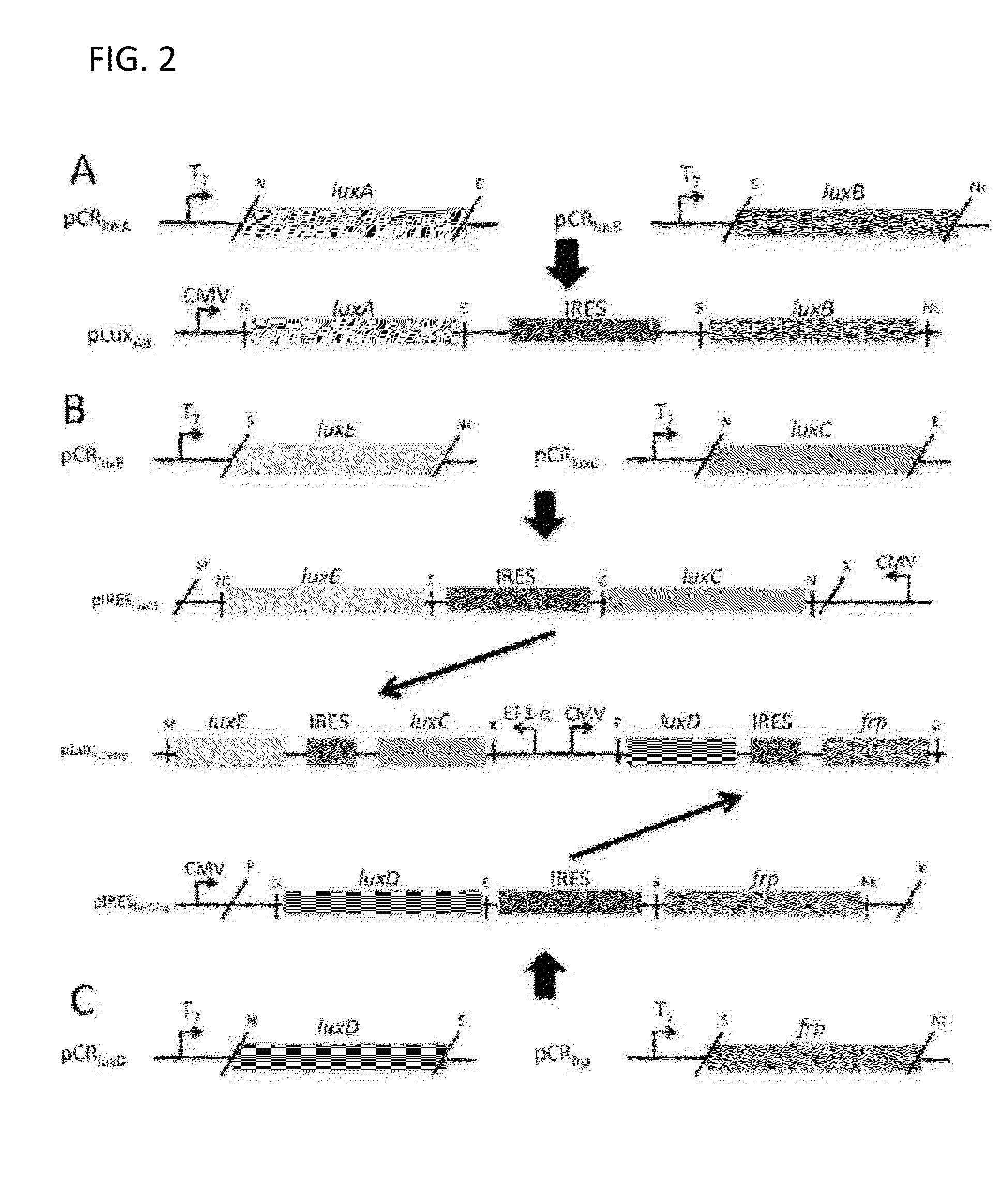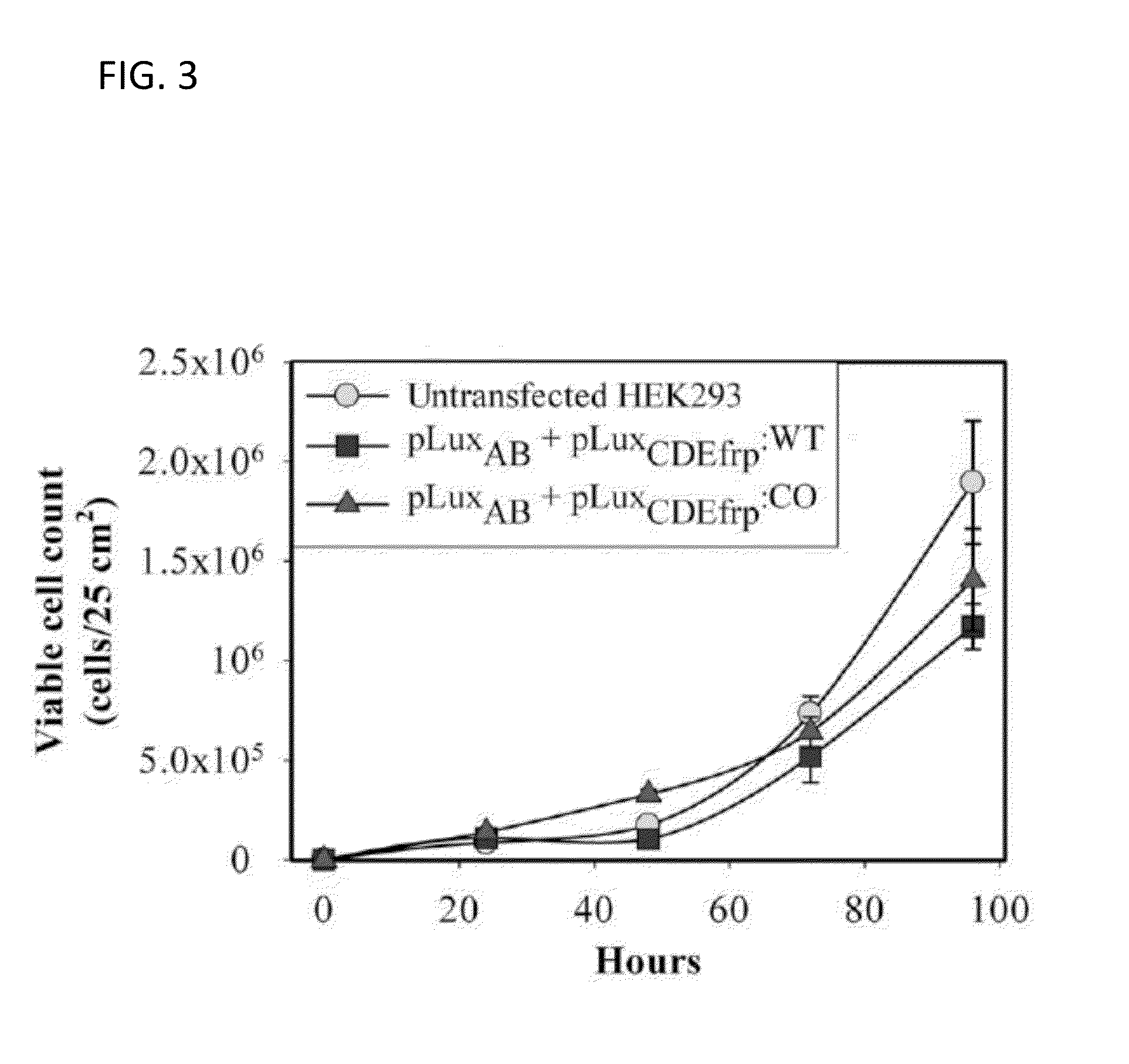Autonomous lux reporter system and methods of use
a reporter system and autonomous technology, applied in the field of biosensors, can solve the problems of slow, more straightforward methods, and high cost of exposure to man-made and natural environmental agents, and achieve the effects of reducing the risk of cancer
- Summary
- Abstract
- Description
- Claims
- Application Information
AI Technical Summary
Benefits of technology
Problems solved by technology
Method used
Image
Examples
example 1
Autonomous Bioluminescent Production in a Mammalian Cellular Background
Materials and Methods
[0118]Strain Maintenance and Growth:
[0119]Escherichia coli cells were routinely grown in Luria Bertani (LB) broth with continuous shaking (200 rpm) at 37° C. When required, kanamycin or ampicillin was used at final concentrations of 40 and 100 μg / ml, respectfully, for selection of plasmid containing cells. Mammalian cell lines were propagated in Eagle's modified essential medium (EMEM) supplemented with 10% fetal bovine serum, 0.01 mM non-essential amino acids, and 0.01 mM sodium pyruvate. Cell growth was carried out at 37° C. in a 5% CO2 environment and cells were passaged every 3-4 d upon reaching 80% confluence. Neomycin and / or zeocin were used for selection of transfected cells at concentrations of 500 μg / ml and 200 μg / ml, respectfully, as determined by kill curve analysis, for each antibiotic.
[0120]Codon Optimization of the Bacterial Bioluminescence Genes:
[0121]Codon usage patterns in th...
example 2
Comparison of Mammalian-Adapted Bacterial Bioluminescence with Firefly Luciferase Bioluminescence and Fluorescence from the Green Fluorescent Protein
[0161]As disclosed herein, it has been demonstrated that autonomous bioluminescent production from a mammalian cell line expressing human-optimized (ho) bacterial luciferase (lux) cassette genes can be used as a target for cell culture and small animal bioluminescent imaging (BLI). In this example, the bioluminescent expression of a mammalian HEK293 cell line transfected with the holux genes is compared with the bioluminescent expression of the same cell line expressing a commercially available, ho-firefly luciferase gene (luc) and the fluorescent expression of a commercially available, improved green fluorescent protein (GFP). The luc and gfp genes are two of the most widely known and used reporter genes for optical imaging and therefore provide excellent points of comparison for determining if holux expression would be beneficial in a...
example 3
Use of Mammalian-Adapted Bacterial Luciferase Genes as a Reporter System for Use in the Mammalian Cellular Background
[0235]For many years researchers have been using bacteria and simple eukaryotes such as yeast to serve as proxies for measuring the bioavailability of exposed chemicals to human cells. These simple models have distinct advantages of being easy to manipulate in the laboratory, inexpensive to maintain, and highly amenable to high throughput experimental design. However, as attractive as they might be, they are not completely representative of human derived cells. As such, there is always some amount of caution that must be taken when interpreting the data obtained using these models and relating it to human bioavailability. Oftentimes human derived cells cannot be used for bioavailability screening because of the lack of reporter systems allowing for real-time, autonomous reporting of the associated effects.
[0236]As disclosed herein, the use of human derived HEK293 cell...
PUM
 Login to View More
Login to View More Abstract
Description
Claims
Application Information
 Login to View More
Login to View More - R&D
- Intellectual Property
- Life Sciences
- Materials
- Tech Scout
- Unparalleled Data Quality
- Higher Quality Content
- 60% Fewer Hallucinations
Browse by: Latest US Patents, China's latest patents, Technical Efficacy Thesaurus, Application Domain, Technology Topic, Popular Technical Reports.
© 2025 PatSnap. All rights reserved.Legal|Privacy policy|Modern Slavery Act Transparency Statement|Sitemap|About US| Contact US: help@patsnap.com



